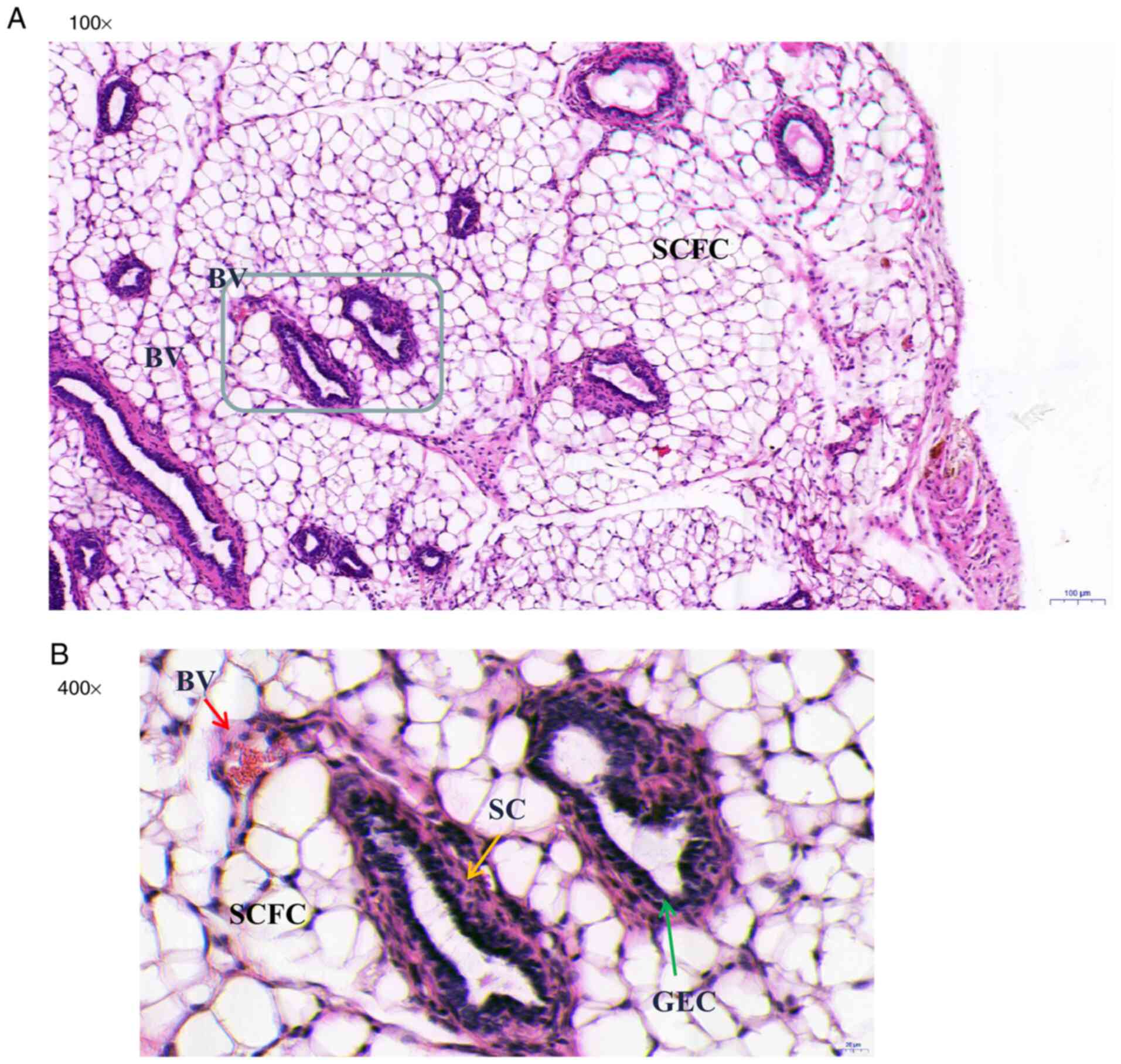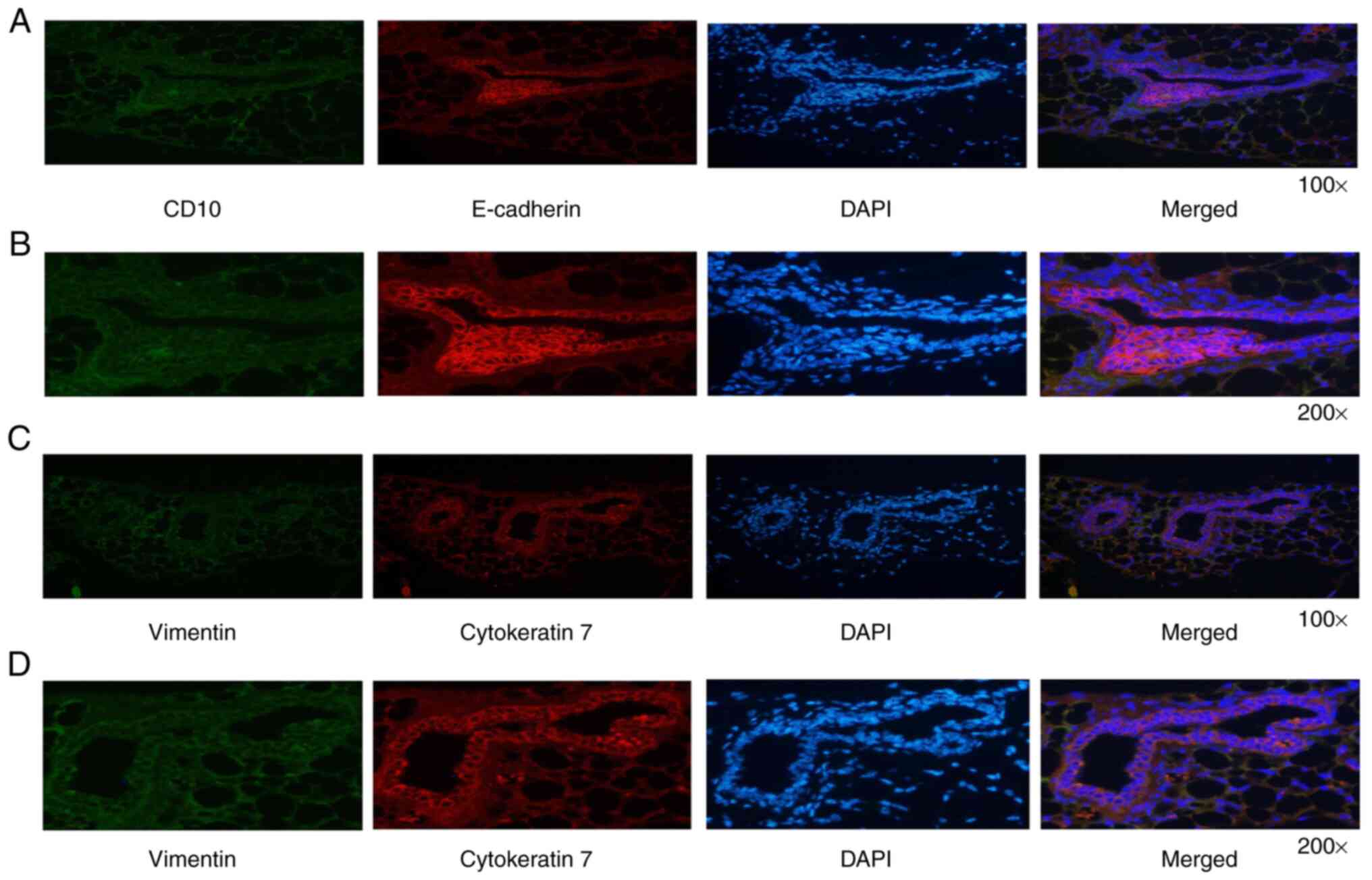|
1
|
Koninckx PR, Ussia A, Adamyan L, Wattiez
A, Gomel V and Martin DC: Pathogenesis of endometriosis: The
genetic/epigenetic theory. Fertil Steril. 111:327–340.
2019.PubMed/NCBI View Article : Google Scholar
|
|
2
|
Rolla E: Endometriosis: Advances and
controversies in classification, pathogenesis, diagnosis, and
treatment. F1000Res 8: F1000 Faculty Rev-529, 2019.
|
|
3
|
Zondervan KT, Becker CM and Missmer SA:
Endometriosis. N Engl J Med. 382:1244–1256. 2020.PubMed/NCBI View Article : Google Scholar
|
|
4
|
Czyzyk A, Podfigurna A, Szeliga A and
Meczekalski B: Update on endometriosis pathogenesis. Minerva
Ginecol. 69:447–461. 2017.PubMed/NCBI View Article : Google Scholar
|
|
5
|
Vercellini P, Vigano P, Somigliana E and
Fedele L: Endometriosis: Pathogenesis and treatment. Nat Rev
Endocrinol. 10:261–275. 2014.PubMed/NCBI View Article : Google Scholar
|
|
6
|
D'Hooghe TM, Bambra CS, Cornillie FJ,
Isahakia M and Koninckx PR: Prevalence and laparoscopic appearance
of spontaneous endometriosis in the baboon (Papio anubis,
Papio cynocephalus). Biol Reprod. 45:411–416.
1991.PubMed/NCBI View Article : Google Scholar
|
|
7
|
Hastings JM and Fazleabas AT: A baboon
model for endometriosis: Implications for fertility. Reprod Biol
Endocrinol. 4 (Suppl 1)(S7)2006.PubMed/NCBI View Article : Google Scholar
|
|
8
|
Taylor HS, Alderman Iii M, D'Hooghe TM,
Fazleabas AT and Duleba AJ: Effect of simvastatin on baboon
endometriosis. Biol Reprod. 97:32–38. 2017.PubMed/NCBI View Article : Google Scholar
|
|
9
|
Burns KA, Pearson AM, Slack JL, Por ED,
Scribner AN, Eti NA and Burney RO: Endometriosis in the Mouse:
Challenges and progress toward a ‘Best Fit’ murine model. Front
Physiol. 12(806574)2022.PubMed/NCBI View Article : Google Scholar
|
|
10
|
Fan H: In-vitro models of human
endometriosis. Exp Ther Med. 19:1617–1625. 2020.PubMed/NCBI View Article : Google Scholar
|
|
11
|
Bruner-Tran KL, Webster-Clair D and Osteen
KG: Experimental endometriosis: The nude mouse as a xenographic
host. Ann NY Acad Sci. 955:328–342, 396-406. 2002.PubMed/NCBI View Article : Google Scholar
|
|
12
|
Perello M, Gonzalez-Foruria I, Castillo P,
Martínez-Florensa M, Lozano F, Balasch J and Carmona F: Oral
administration of pentoxifylline reduces endometriosis-like lesions
in a nude mouse model. Reprod Sci. 24:911–918. 2017.PubMed/NCBI View Article : Google Scholar
|
|
13
|
Wang N, Hong S, Tan J, Ke P, Liang L, Fei
H, Liu B, Liu L, Liu Y and Yu B: A red fluorescent nude mouse model
of human endometriosis: Advantages of a non-invasive imaging
method. Eur J Obstet Gynecol Reprod Biol. 176:25–30.
2014.PubMed/NCBI View Article : Google Scholar
|
|
14
|
Ni HJ, Zhang Z, Dai YD and Zhang SY:
Establishment of endometriosis subcutaneous model in
immunodeficient nude mice. Zhonghua Yi Xue Za Zhi. 96:2675–2677.
2016.PubMed/NCBI View Article : Google Scholar : (In Chinese).
|
|
15
|
Wang J and Ma X: Effects of estrogen and
progestin on expression of MMP-2 and TIMP-2 in a nude mouse model
of endometriosis. Clin Exp Obstet Gynecol. 39:229–233.
2012.PubMed/NCBI
|
|
16
|
Wu D, Lu P, Mi X and Miao J: Exosomal
miR-214 from endometrial stromal cells inhibits endometriosis
fibrosis. Mol Hum Reprod. 24:357–365. 2018.PubMed/NCBI View Article : Google Scholar
|
|
17
|
Zeitvogel A, Baumann R and
Starzinski-Powitz A: Identification of an invasive,
N-cadherin-expressing epithelial cell type in endometriosis using a
new cell culture model. Am J Pathol. 159:1839–1852. 2001.PubMed/NCBI View Article : Google Scholar
|
|
18
|
American Veterinary Medical Association
2020. AVMA Guidelines for the Euthanasia of Animals. 9th edition.
American Veterinary Medical Association, Schaumburg, IL, 2020.
|
|
19
|
Luo Y, Zou Y, Wu J, Zhang ZY, Liu FY, Li
LP and Huang OP: The mitochondrial DNA 4977-bp deletion and copy
number alteration in Han Chinese samples with uterine fibroids. Ann
Hum Genet. 83:220–230. 2019.PubMed/NCBI View Article : Google Scholar
|
|
20
|
Guerrieri C, Franlund B and Boeryd B:
Expression of cytokeratin 7 in simultaneous mucinous tumors of the
ovary and appendix. Mod Pathol. 8:573–576. 1995.PubMed/NCBI
|
|
21
|
Mishra A, Galvankar M, Vaidya S, Chaudhari
U and Modi D: Mouse model for endometriosis is characterized by
proliferation and inflammation but not epithelial-to-mesenchymal
transition and fibrosis. J Biosci. 45(105)2020.PubMed/NCBI
|
|
22
|
Atkins HM, Lombardini ED, Caudell DL, Appt
SE, Dubois A and Cline JM: Decidualization of endometriosis in
macaques. Vet Pathol. 53:1252–1258. 2016.PubMed/NCBI View Article : Google Scholar
|
|
23
|
Greaves E, Cousins FL, Murray A,
Esnal-Zufiaurre A, Fassbender A, Horne AW and Saunders PT: A novel
mouse model of endometriosis mimics human phenotype and reveals
insights into the inflammatory contribution of shed endometrium. Am
J Pathol. 184:1930–1939. 2014.PubMed/NCBI View Article : Google Scholar
|
|
24
|
Giudice LC: Clinical practice.
Endometriosis. N Engl J Med. 362:2389–2398. 2010.PubMed/NCBI View Article : Google Scholar
|
|
25
|
Nishimoto-Kakiuchi A, Netsu S, Matsuo S,
Hayashi S, Ito T, Okabayashi S, Yasmin L, Yuzawa K, Kondoh O, Kato
A, et al: Characteristics of histologically confirmed endometriosis
in cynomolgus monkeys. Hum Reprod. 31:2352–2359. 2016.PubMed/NCBI View Article : Google Scholar
|
|
26
|
Saltan G, Suntar I, Ozbilgin S, Ilhan M,
Demirel MA, Oz BE, Keleş H and Akkol EK: Viburnum opulus L: A
remedy for the treatment of endometriosis demonstrated by rat model
of surgically-induced endometriosis. J Ethnopharmacol. 193:450–455.
2016.PubMed/NCBI View Article : Google Scholar
|
|
27
|
Simitsidellis I, Gibson DA and Saunders
PTK: Animal models of endometriosis: Replicating the aetiology and
symptoms of the human disorder. Best Pract Res Clin Endocrinol
Metab. 32:257–269. 2018.PubMed/NCBI View Article : Google Scholar
|
|
28
|
D'Hooghe TM, Kyama CM, Chai D, Fassbender
A, Vodolazkaia A, Bokor A and Mwenda JM: Nonhuman primate models
for translational research in endometriosis. Reprod Sci.
16:152–161. 2009.PubMed/NCBI View Article : Google Scholar
|
|
29
|
Harirchian P, Gashaw I, Lipskind ST,
Braundmeier AG, Hastings JM, Olson MR and Fazleabas AT: Lesion
kinetics in a non-human primate model of endometriosis. Hum Reprod.
27:2341–2351. 2012.PubMed/NCBI View Article : Google Scholar
|
|
30
|
Chadchan SB, Cheng M, Parnell LA, Yin Y,
Schriefer A, Mysorekar IU and Kommagani R: Antibiotic therapy with
metronidazole reduces endometriosis disease progression in mice: A
potential role for gut microbiota. Hum Reprod. 34:1106–1116.
2019.PubMed/NCBI View Article : Google Scholar
|
|
31
|
Li M, Zhou Y and Taylor HS: MiR-451a
inhibition reduces established endometriosis lesions in mice.
Reprod Sci. 26:1506–1511. 2019.PubMed/NCBI View Article : Google Scholar
|
|
32
|
Sun H, Li D, Yuan M, Li Q, Zhen Q, Li N
and Wang G: Macrophages alternatively activated by
endometriosis-exosomes contribute to the development of lesions in
mice. Mol Hum Reprod. 25:5–16. 2019.PubMed/NCBI View Article : Google Scholar
|
|
33
|
Bruner-Tran KL, Mokshagundam S, Herington
JL, Ding T and Osteen KG: Rodent models of experimental
endometriosis: Identifying mechanisms of disease and therapeutic
targets. Curr Womens Health Rev. 14:173–188. 2018.PubMed/NCBI View Article : Google Scholar
|
|
34
|
Korbel C, Menger MD and Laschke MW: Size
and spatial orientation of uterine tissue transplants on the
peritoneum crucially determine the growth and cyst formation of
endometriosis-like lesions in mice. Hum Reprod. 25:2551–2558.
2010.PubMed/NCBI View Article : Google Scholar
|
|
35
|
Pelch KE, Sharpe-Timms KL and Nagel SC:
Mouse model of surgically-induced endometriosis by
auto-transplantation of uterine tissue. J Vis Exp.
59(e3396)2012.PubMed/NCBI View
Article : Google Scholar
|
|
36
|
Wallwiener D, Meyer A and Bastert G:
Adhesion formation of the parietal and visceral peritoneum: An
explanation for the controversy on the use of autologous and
alloplastic barriers? Fertil Steril. 69:132–137. 1998.PubMed/NCBI View Article : Google Scholar
|
|
37
|
Hull ML, Escareno CR, Godsland JM, Doig
JR, Johnson CM, Phillips SC, Smith SK, Tavaré S, Print CG and
Charnock-Jones DS: Endometrial-peritoneal interactions during
endometriotic lesion establishment. Am J Pathol. 173:700–715.
2008.PubMed/NCBI View Article : Google Scholar
|
|
38
|
Hull ML, Prentice A, Wang DY, Butt RP,
Phillips SC, Smith SK and Charnock-Jones DS: Nimesulide, a COX-2
inhibitor, does not reduce lesion size or number in a nude mouse
model of endometriosis. Hum Reprod. 20:350–358. 2005.PubMed/NCBI View Article : Google Scholar
|
|
39
|
Nisolle M, Casanas-Roux F and Donnez J:
Early-stage endometriosis: Adhesion and growth of human menstrual
endometrium in nude mice. Fertil Steril. 74:306–312.
2000.PubMed/NCBI View Article : Google Scholar
|
|
40
|
Eggermont J, Donnez J, Casanas-Roux F,
Scholtes H and Van Langendonckt A: Time course of pelvic
endometriotic lesion revascularization in a nude mouse model.
Fertil Steril. 84:492–499. 2005.PubMed/NCBI View Article : Google Scholar
|
|
41
|
Gonzalez-Ramos R, Van Langendonckt A,
Defrere S, Lousse JC, Mettlen M, Guillet A and Donnez J: Agents
blocking the nuclear factor-kappaB pathway are effective inhibitors
of endometriosis in an in vivo experimental model. Gynecol Obstet
Invest. 65:174–186. 2008.PubMed/NCBI View Article : Google Scholar
|
|
42
|
Pereira FE, Almeida PR, Dias BH,
Vasconcelos PR, Guimaraes SB and Medeiros Fd: Development of a
subcutaneous endometriosis rat model. Acta Cir Bras. 30:6–12.
2015.PubMed/NCBI View Article : Google Scholar
|
|
43
|
Banu SK, Starzinski-Powitz A, Speights VO,
Burghardt RC and Arosh JA: Induction of peritoneal endometriosis in
nude mice with use of human immortalized endometriosis epithelial
and stromal cells: A potential experimental tool to study molecular
pathogenesis of endometriosis in humans. Fertil Steril. 91 (Suppl
5):S2199–S2209. 2009.PubMed/NCBI View Article : Google Scholar
|


















